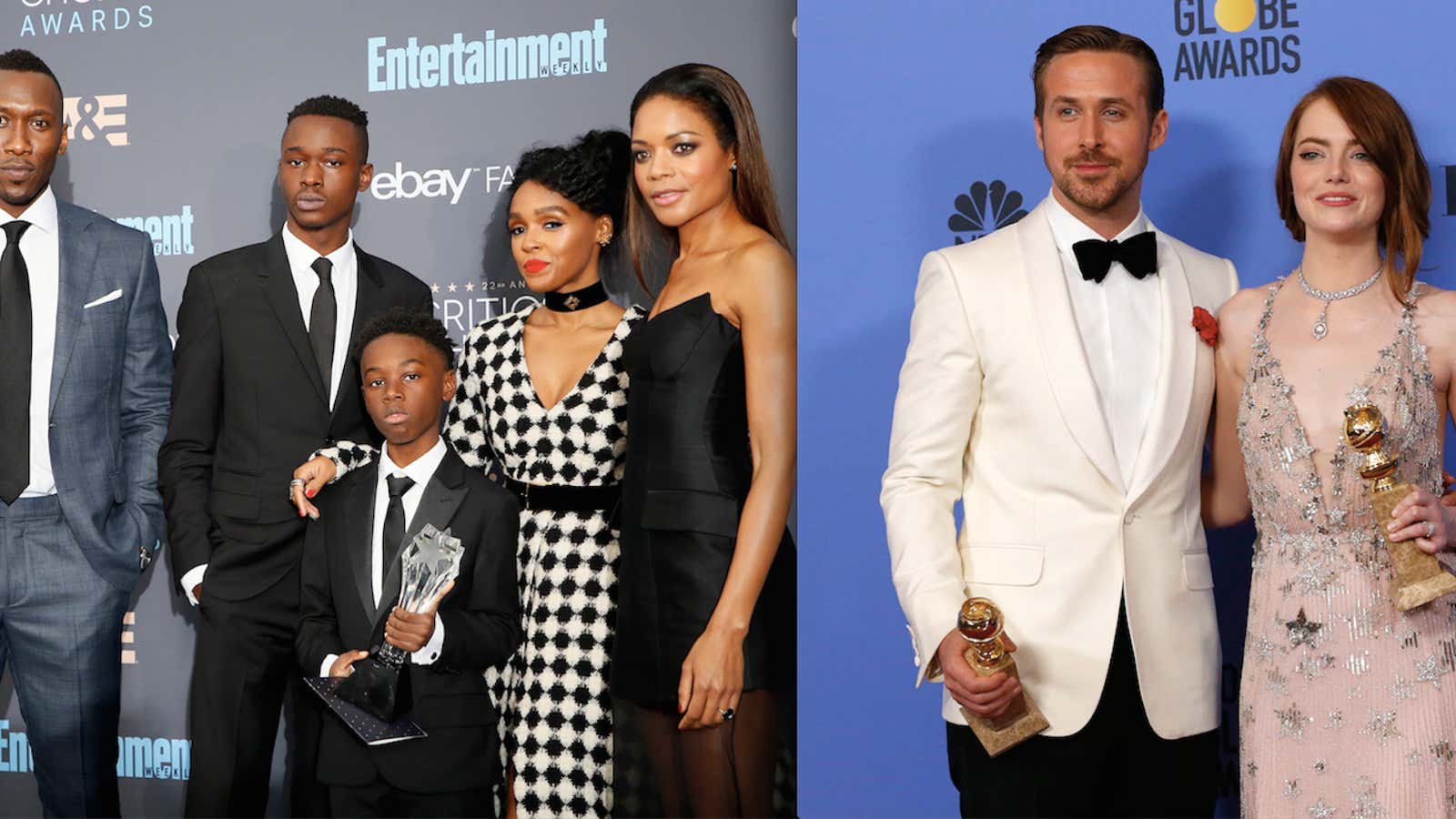Adele’s upset win over Beyonce at the 2017 Grammy Awards shocked many music lovers, who saw the outcome as a reflection of the racism endemic to the industry. The Academy Awards are unlikely to be much different—at least where Best Picture is concerned.
Adele’s surprise Album of the Year win sparked the hashtag #GrammysSoWhite along with a welcome conversation on white privilege. “Simply put, the Grammys have an inclusion problem—or more to the point, an exclusion problem,” Jon Caramanica wrote for the New York Times. “It was a show about borders—who is allowed to cross, who isn’t and who doesn’t even bother trying.”
It was also a reminder of the subtle ways whiteness influences the arts, specifically when it comes time to decide what is the “best” of the best. When equally excellent white and non-white artists are evaluated against each other, the plurality within America’s cultural gatekeepers and tastemakers seem to favor the “safe” choice—in other words, the white one.
This year’s critical hit La La Land has had a much more muted public reception, with many criticizing its bland—and literally colorless—depiction of the entertainment industry. Regardless, it has tied Titanic as the most-nominated film and appears poised to win Best Picture.
Meanwhile, many of the other nominees, seem like a refreshing departure for an industry plagued by diversity problems. Best Picture nominees Moonlight, Hidden Figures, and Fences collectively tackle issues of poverty, sexuality, gender, and race, and are rooted in the histories and experiences of black people. Lion focuses on the experience of an orphaned young Indian boy who, after getting lost on a train, comes of age while journeying back to his native land.
The five other nominated films, with La La Land chief among them, focus on a range of white protagonists and plot lines—from apocalyptic tales (Arrival), to wartime narratives (Hacksaw Ridge), to treatises about family struggles (Manchester by the Sea, Hell or High Water).
In a crowded field, Moonlight, which depicts the struggles of a queer black man, has been lauded by critics and audience members alike. A win for Moonlight would send a powerful message about the Academy’s ability to recognize diverse storytelling.
But don’t bet on it.
First, the media and entertainment industries are a reflection of prevailing social politics. Now more than ever, white identity politics has become a prime focus in the national conversation. With this renewed focus comes a resurgence of nostalgia for the supposed idyllic social order of the mid-20th century. “Those were the days,” as Archie Bunker would sing during the opening credits for the sitcom All in The Family. Or, for a more recent clarion call, Donald Trump’s campaign slogan, “Make America Great Again.”
As Laila Imani wrote for New York Times Magazine, whiteness in the US is seen as the default, as the absence of race. It exists as an identity category, and somehow, at the same time, it doesn’t exist at all.
La La Land, with its old Hollywood aesthetic and cultural references, harkens back to a time when white images were even more dominant and pervasive than they are now. (It’s also a Hollywood-made movie about Hollywood, and Hollywood loves to congratulate itself as much as it can.)
This nostalgia becomes even more potent when we look at the people who are actually determining who wins and who goes home. Last year, the Motion Picture Academy instituted changes to diversify its board membership. Cheryl Boone Isaacs, the academy’s president and a black woman herself, pledged to double the number of women and multicultural individuals in the ranks—yet the recent changes only boosted that number from 8% to 11%.
In the meantime, as the Los Angeles Times noted, the academy is still overwhelmingly white (89%) and male (73%). This means the voting base still reflects a relatively insular Hollywood establishment. While it’s not wholly accurate to characterize white men as a monolithic voting bloc, their sensibilities en masse carry incredible weight. They still have disproportionate control over which movie scripts get green-lighted, who gets hired for casts and crews, and, as the final and logical result of those initial choices, who nabs the Oscar.
Numbers prove the diversity gap remains wide. A study recently released by the Bunche Center for African American Studies at UCLA concluded that Hollywood still has a long way to go on racial diversity. In an interview with the Los Angeles Times, Darnell Hunt, the center’s director, said that although television is making some measurable progress, things “haven’t really progressed” at the movies.
Maybe something miraculous actually happens at the Oscars. But assuming La La Land wins, remember that “diverse” casts can never be fully and fairly recognized when whiteness is considered the standard.
